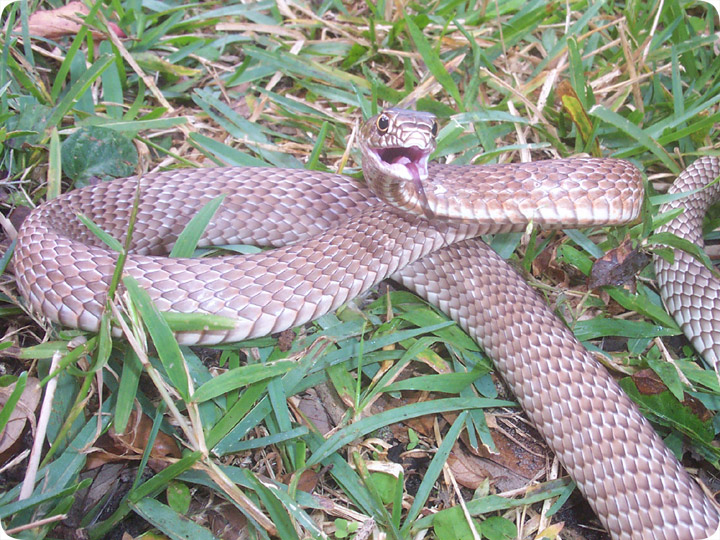-
info@aaanimalcontrol.com
Call us for help in your town
Humane Wildlife Education
Fastest Snake in America

09.22.2005 - This is the fastest snake in the United States of America, the Eastern Coachwhip. It has a top land speed of about 10 m.p.h. and a top air speed of 190 m.p.h. like most aerodynamic objects reaching terminal velocity. Ten miles per
hour may not seem fast, but it is. It's a fast snake! I've seen only two in my life. I caught the above snake, and it took all of my speed and cunning. The second Coachwhip that I saw was too fast for me to nab, and it escaped under a mobile home.
This snake is fairly rare, but another more common snake, the Black Racer, is almost as fast. Both of these snakes have excellent acceleration, and can dart from place to place very quickly.
I don't understand the physiology of the snake, but it's built for speed, and is sleek and muscular, unlike slower, fatter snakes. I'm not sure why this snake needs to be
fast, but of course the two best guesses are that it uses speed to catch its prey or to escape predators, or both.
I think this is one of the best wildlife photos
that I've taken. I love the pose, the color of the snake, and I don't quite understand it, but you can see that the snake's tongue is translucent. I don't know if
this is some camera effect or what, but it looks cool.
Do it yourself: Visit my How To Get Rid of Snakes page for tips and advice.
Get professional help: Visit my Nationwide Pro Directory of wildlife removal experts.
For more wildlife stories, click my Wildlife Blog
or click my below banner to hire a local trapper.
You can also catch snakes with a special trap, which you can order by clicking this banner:

The sidewinder is the fastest snake found in America. It is a carnivorous snake that is most commonly found in the northern region of America especially in the Sonoran and Mohave deserts. They belong to the rattlesnake specie and are venomous although their venom is not that strong. Contrary to common belief, they are shy which inhibits them from attacking and biting too many people. They are nocturnal and even if they attack, it is usually after dark because that is when they leave their shelters and smell the air to track their prey. Their prey usually consists of lizards and small rodents.
Their shelter mostly consists of them burying themselves in the sand through a special movement during the daytime. To protect themselves against the scorching heat they find shade under a dense bush. They attract their prey by moving their tail in slow motion. They then only have their heads on the surface and wait patiently for an animal to come close to them. Once it is, the snake will leap onto it and bite it to paralyze it. The animal then dies and the sidewinder swallows it after going deep into the sand where other sidewinders are also present.
Sidewinders have special locomotion which enables special movement making it the fastest snake in the United States. They do not use lateral undulation which is common amongst snakes to make movements. Unlike other snakes, they move and slither their body in a way that leaves marks on the sand which is further used to push forward with a lot of force. All of this increases the speed of the sidewinder and makes it the fastest snake in the United States of America. To move forward with such a speed of 29 km/hour, they need their fair share of meals to give them energy. These snakes are carnivorous and prey on rodents, kangaroo rats, and lizards; they enjoy the fringe-toed lizard the most. However, if these snakes are kept in the zoo, their diet then mainly consists of mice.
Every animal has a different pattern when it comes to mating. The same can be observed for sidewinder snakes. The female sidewinders give birth and do not lay any eggs. Once it has given birth, it stays with the young for some time; the shedding of a snake's skin marks when it leaves its mother's side and becomes independent. It might come as a surprise that it sheds its skin 7-10 days after being born. The snakes become mature enough 2-3 years after birth and can mate and produce their offspring in the same year. The sidewinder stays in hibernation during the winters. Since the snake is mostly present in deserts, it finds burrows itself in a hole previously used by rodents to hibernate. The lifespan of a sidewinder snake is usually short; 5 for females and 13 for males. However, if they are not in a wild environment and are kept captive, they can live up to 20 years.




















